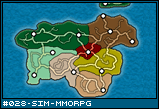| Three Hundred |
| - Index Page |
| - About... |
| - By Year |
| Collections |
| - Comp-Grid |
| - Procedural |
| - Tactics |
| - Tiny Crawl |
| - Misc |
| Previous | Mechanic #072 | Next |
This is the third and final entry in the three part Tiny World series describing a sim-RPG, like as if the Sims brandished swords. The first part discussed character evolution through the design of homes and guilds. The second part described a manner of seeing what the sim-adventurers were thinking, and even having some say in the matter. This entry concerns itself with dungeons and the Adventurer's Guild. When one thinks of a sim game, one invariably thinks about building. This is probably because the first major sim game was SimCity. Nearly every offshoot of the sim genre has involved building things, even Real Time Strategy games. I'd say that probably most games considered a sim involve building. Even my first entry in this mini-series concerned building. However, with dungeons, I didn't want to go that route. Partly because it had been done before with the likes of Dungeon Keeper. And partly because a sim-RPG isn't about the dungeon. It's about the sim-adventurers. Putting too much effort or time into manipulating dungeons would be micro-management hell. You'd only have the energy to work on one dungeon at a time - and I want players to be managing dozens.
I mentioned in [#070 - Tiny World Cities] that there was a single building which could not be built, upgraded, or destroyed: the Adventurer's Guild. All sim-adventurers in the game, regardless of rank or guild, belongs to this guild. Simply put, the AG puts up quests for the adventurer's to go on. These quests are optional. The posting includes a difficulty, level, and number of people required. When an adventurer's basic goals have been met, he will visit the guild to get a quest. Whether he groups up on one or takes a solo one is largely up to the personality of the sim, though he won't wait around forever. The player has the ability to add quests to the guild. For instance, he may only see in dungeons as far as it has been explored by the adventurers. In that case, he might put an exploration quest out on the dungeon in which an adventurer will succeed after he has removed all fog of war. Maybe he wants adventurers to go to Dungeon X, which has previously been ignored in favor of other dungeons. Then he just puts a kill quota on that dungeon (kill 10 enemies in Dungeon X). ![[group1.png]](set04/img/entry072-group1.png) Groups in Tiny World can have up to three adventurers in to. They walk in a line with a front, middle, and back unit. Depending on which position the unit is in, it may have different abilities it can do. For instance, an archer in the front attacks with a knife, but an archer in the middle / back uses a bow. Each profession has a preferred spot on the team, and by and large, having three random adventurers get together will result in an optimal setup. These teams have a single, shared goal added to their goal queue, with the highest priority. For all intents and purposes, these three units act as one entity. Even though they may achieve other goals in the field, they will not actively pursue any. Once they have accomplished their mission, they will return to the guild for money, exp, and whatever.
|
![[dung1.png]](set04/img/entry072-dung1.png)

![[unlock1.png]](set04/img/entry072-unlock1.png)
![[unlock2.png]](set04/img/entry072-unlock2.png)





